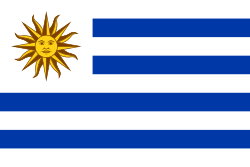| Uruguay at the 1924 Summer Olympics | |
|---|---|
 | |
| IOC code | URU |
| NOC | Uruguayan Olympic Committee |
| in Paris | |
| Competitors | 33 in 3 sports |
| Medals Ranked 19th |
|
| Summer Olympics appearances (overview) | |
Uruguay competed in the Summer Olympic Games for the first time at the 1924 Summer Olympics in Paris, France.